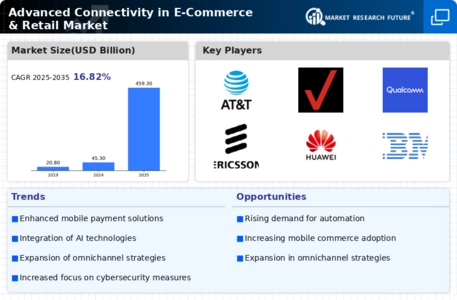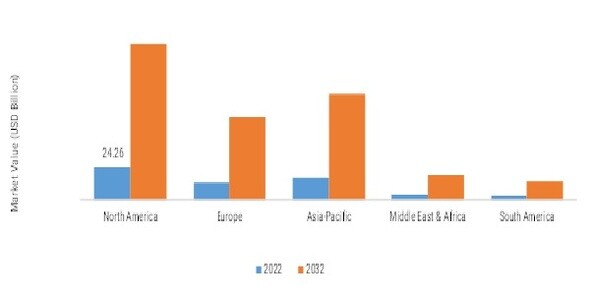Market Growth Projections
The Global Advanced Connectivity in E-Commerce & Retail Market Industry is poised for remarkable growth, with projections indicating a substantial increase in market value. As of 2024, the market is valued at 45.3 USD Billion, and it is expected to reach 459.3 USD Billion by 2035. This growth trajectory reflects a compound annual growth rate of 23.43% from 2025 to 2035. Such figures highlight the increasing importance of advanced connectivity solutions in the retail sector, as businesses strive to enhance customer experiences and streamline operations. The anticipated growth underscores the potential for innovation and investment in this dynamic market.
Expansion of Mobile Commerce
The proliferation of mobile devices is significantly influencing the Global Advanced Connectivity in E-Commerce & Retail Market Industry. With a growing number of consumers using smartphones for shopping, retailers are compelled to optimize their platforms for mobile access. This trend is evident as mobile commerce continues to gain traction, accounting for a substantial portion of online sales. As of 2024, the market is valued at 45.3 USD Billion, with projections indicating it could soar to 459.3 USD Billion by 2035. Retailers are increasingly investing in mobile-friendly interfaces and payment solutions to cater to this expanding demographic, thereby enhancing connectivity and user engagement.
Rapid Digital Transformation
The Global Advanced Connectivity in E-Commerce & Retail Market Industry is experiencing a surge due to rapid digital transformation across various sectors. Businesses are increasingly adopting digital technologies to enhance customer experiences and streamline operations. For instance, the integration of artificial intelligence and machine learning in e-commerce platforms allows for personalized shopping experiences, which is crucial in retaining customers. As of 2024, the market is valued at 45.3 USD Billion, indicating a robust growth trajectory. This transformation is expected to continue, with projections suggesting that by 2035, the market could reach 459.3 USD Billion, highlighting the critical role of digital advancements in shaping the future of retail.
Increased Consumer Expectations
Consumer expectations are evolving, driving the Global Advanced Connectivity in E-Commerce & Retail Market Industry to adapt and innovate. Shoppers today demand seamless, fast, and personalized experiences, which necessitates advanced connectivity solutions. Retailers are leveraging technologies such as augmented reality and virtual reality to enhance the shopping experience, allowing consumers to visualize products in their own environments. This shift is reflected in the market's anticipated growth, with a compound annual growth rate of 23.43% projected from 2025 to 2035. As businesses strive to meet these heightened expectations, the industry is likely to witness significant advancements in connectivity solutions.
Emergence of Omnichannel Strategies
The rise of omnichannel retailing is reshaping the Global Advanced Connectivity in E-Commerce & Retail Market Industry. Retailers are increasingly adopting integrated approaches that combine online and offline channels to provide a cohesive shopping experience. This strategy not only enhances customer satisfaction but also drives sales growth. For example, brands are utilizing data analytics to understand consumer behavior across various platforms, allowing for targeted marketing efforts. The market's growth trajectory, with a projected CAGR of 23.43% from 2025 to 2035, underscores the importance of omnichannel strategies in fostering deeper customer relationships and improving overall connectivity.
Investment in Cybersecurity Solutions
As the Global Advanced Connectivity in E-Commerce & Retail Market Industry expands, the need for robust cybersecurity measures becomes paramount. Retailers are increasingly investing in advanced security solutions to protect sensitive customer data and maintain trust. With the rise in online transactions, the potential for cyber threats has escalated, prompting businesses to prioritize cybersecurity. This investment not only safeguards against breaches but also enhances the overall shopping experience by ensuring secure transactions. As the market evolves, the emphasis on cybersecurity is likely to play a critical role in shaping consumer confidence and driving further growth.



 Source: Secondary Research, Primary Research, MRFR Database, and Analyst Review
Source: Secondary Research, Primary Research, MRFR Database, and Analyst Review

















Leave a Comment